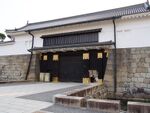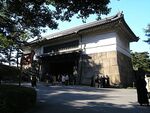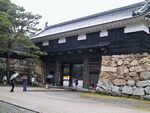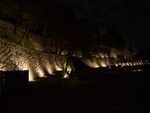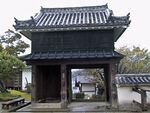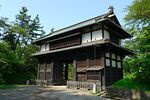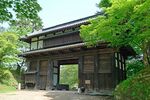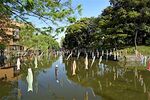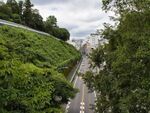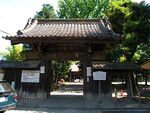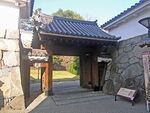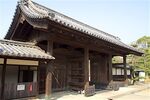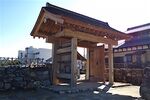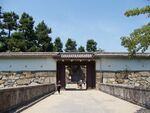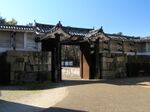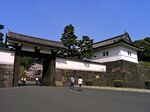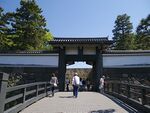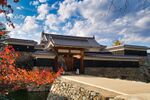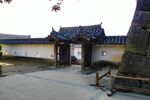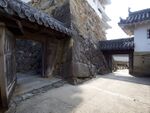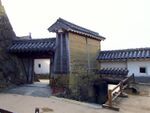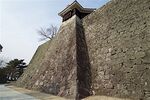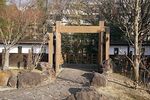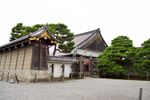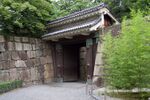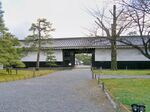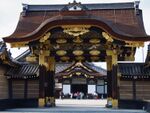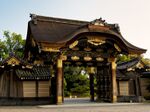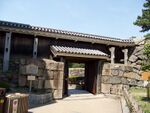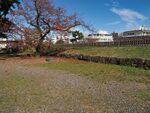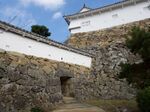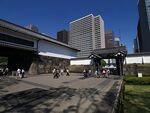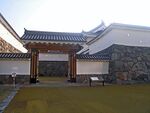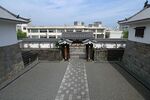Loading map...
{"format":"leaflet","minzoom":false,"maxzoom":false,"limit":500,"offset":0,"link":"all","sort":[""],"order":[],"headers":"show","mainlabel":"","intro":"","outro":"","searchlabel":"... further results","default":"","import-annotation":false,"width":"auto","height":"600px","centre":false,"title":"","label":"","icon":"Darkgreen18.png","lines":[],"polygons":[],"circles":[],"rectangles":[],"copycoords":false,"static":false,"zoom":false,"defzoom":14,"layers":["Esri.WorldTopoMap"],"image layers":[],"overlays":[],"resizable":false,"fullscreen":false,"scrollwheelzoom":true,"cluster":false,"clustermaxzoom":20,"clusterzoomonclick":true,"clustermaxradius":80,"clusterspiderfy":true,"geojson":"","clicktarget":"","showtitle":true,"hidenamespace":true,"template":"","userparam":"","activeicon":"","pagelabel":false,"ajaxcoordproperty":"","ajaxquery":"","locations":[{"text":"\u003Cb\u003E\u003Ca href=\"/view/Aizu_Wakamatsu_Castle\" title=\"Aizu Wakamatsu Castle\"\u003EAizu Wakamatsu Castle\u003C/a\u003E\u003C/b\u003E","title":"Aizu Wakamatsu Castle","link":"","lat":37.48777,"lon":139.9299,"icon":"../images/d/db/Darkgreen18.png"},{"text":"\u003Cb\u003E\u003Ca href=\"/view/Akasaka_Jin%27ya\" title=\"Akasaka Jin\u0026#039;ya\"\u003EAkasaka Jin'ya\u003C/a\u003E\u003C/b\u003E","title":"Akasaka Jin'ya","link":"","lat":34.85605,"lon":137.30672,"icon":"../images/d/db/Darkgreen18.png"},{"text":"\u003Cb\u003E\u003Ca href=\"/view/Akashi_Castle\" title=\"Akashi Castle\"\u003EAkashi Castle\u003C/a\u003E\u003C/b\u003E","title":"Akashi Castle","link":"","lat":34.65231,"lon":134.99186,"icon":"../images/d/db/Darkgreen18.png"},{"text":"\u003Cb\u003E\u003Ca href=\"/view/Akechi_Castle\" title=\"Akechi Castle\"\u003EAkechi Castle\u003C/a\u003E\u003C/b\u003E","title":"Akechi Castle","link":"","lat":35.30359,"lon":137.39445,"icon":"../images/d/db/Darkgreen18.png"},{"text":"\u003Cb\u003E\u003Ca href=\"/view/Akechi_Jin%27ya\" title=\"Akechi Jin\u0026#039;ya\"\u003EAkechi Jin'ya\u003C/a\u003E\u003C/b\u003E","title":"Akechi Jin'ya","link":"","lat":35.30469,"lon":137.39176,"icon":"../images/d/db/Darkgreen18.png"},{"text":"\u003Cb\u003E\u003Ca href=\"/view/Akita_Castle\" title=\"Akita Castle\"\u003EAkita Castle\u003C/a\u003E\u003C/b\u003E","title":"Akita Castle","link":"","lat":39.74039,"lon":140.07969,"icon":"../images/d/db/Darkgreen18.png"},{"text":"\u003Cb\u003E\u003Ca href=\"/view/Akizuki_Castle\" title=\"Akizuki Castle\"\u003EAkizuki Castle\u003C/a\u003E\u003C/b\u003E","title":"Akizuki Castle","link":"","lat":33.46607,"lon":130.69543,"icon":"../images/d/db/Darkgreen18.png"},{"text":"\u003Cb\u003E\u003Ca href=\"/view/Ako_Castle\" title=\"Ako Castle\"\u003EAko Castle\u003C/a\u003E\u003C/b\u003E","title":"Ako Castle","link":"","lat":34.74613,"lon":134.38869,"icon":"../images/d/db/Darkgreen18.png"},{"text":"\u003Cb\u003E\u003Ca href=\"/view/Amaga_Castle\" title=\"Amaga Castle\"\u003EAmaga Castle\u003C/a\u003E\u003C/b\u003E","title":"Amaga Castle","link":"","lat":31.96124,"lon":131.29356,"icon":"../images/d/db/Darkgreen18.png"},{"text":"\u003Cb\u003E\u003Ca href=\"/view/Annaka_Castle\" title=\"Annaka Castle\"\u003EAnnaka Castle\u003C/a\u003E\u003C/b\u003E","title":"Annaka Castle","link":"","lat":36.32939,"lon":138.89655,"icon":"../images/d/db/Darkgreen18.png"},{"text":"\u003Cb\u003E\u003Ca href=\"/view/Aoyagi_Castle\" title=\"Aoyagi Castle\"\u003EAoyagi Castle\u003C/a\u003E\u003C/b\u003E","title":"Aoyagi Castle","link":"","lat":36.43089,"lon":138.03387,"icon":"../images/d/db/Darkgreen18.png"},{"text":"\u003Cb\u003E\u003Ca href=\"/view/Asakura_Yakata\" title=\"Asakura Yakata\"\u003EAsakura Yakata\u003C/a\u003E\u003C/b\u003E","title":"Asakura Yakata","link":"","lat":35.99946,"lon":136.29593,"icon":"../images/d/db/Darkgreen18.png"},{"text":"\u003Cb\u003E\u003Ca href=\"/view/Ashikagashi_Yakata\" title=\"Ashikagashi Yakata\"\u003EAshikagashi Yakata\u003C/a\u003E\u003C/b\u003E","title":"Ashikagashi Yakata","link":"","lat":36.33771,"lon":139.45168,"icon":"../images/d/db/Darkgreen18.png"},{"text":"\u003Cb\u003E\u003Ca href=\"/view/Ashinoya_Jin%27ya\" title=\"Ashinoya Jin\u0026#039;ya\"\u003EAshinoya Jin'ya\u003C/a\u003E\u003C/b\u003E","title":"Ashinoya Jin'ya","link":"","lat":34.85829,"lon":137.16873,"icon":"../images/d/db/Darkgreen18.png"},{"text":"\u003Cb\u003E\u003Ca href=\"/view/Asuke_Castle\" title=\"Asuke Castle\"\u003EAsuke Castle\u003C/a\u003E\u003C/b\u003E","title":"Asuke Castle","link":"","lat":35.13447,"lon":137.32534,"icon":"../images/d/db/Darkgreen18.png"},{"text":"\u003Cb\u003E\u003Ca href=\"/view/Azai_Nishi_Castle\" title=\"Azai Nishi Castle\"\u003EAzai Nishi Castle\u003C/a\u003E\u003C/b\u003E","title":"Azai Nishi Castle","link":"","lat":34.888,"lon":137.10122,"icon":"../images/d/db/Darkgreen18.png"},{"text":"\u003Cb\u003E\u003Ca href=\"/view/Baba_Yashiki\" title=\"Baba Yashiki\"\u003EBaba Yashiki\u003C/a\u003E\u003C/b\u003E","title":"Baba Yashiki","link":"","lat":36.16734,"lon":137.98551,"icon":"../images/d/db/Darkgreen18.png"},{"text":"\u003Cb\u003E\u003Ca href=\"/view/Baba_Yashiki_(Kai)\" title=\"Baba Yashiki (Kai)\"\u003EBaba Yashiki (Kai)\u003C/a\u003E\u003C/b\u003E","title":"Baba Yashiki (Kai)","link":"","lat":35.80828,"lon":138.32756,"icon":"../images/d/db/Darkgreen18.png"},{"text":"\u003Cb\u003E\u003Ca href=\"/view/Bitchu_Matsuyama_Castle\" title=\"Bitchu Matsuyama Castle\"\u003EBitchu Matsuyama Castle\u003C/a\u003E\u003C/b\u003E","title":"Bitchu Matsuyama Castle","link":"","lat":34.80891,"lon":133.62219,"icon":"../images/d/db/Darkgreen18.png"},{"text":"\u003Cb\u003E\u003Ca href=\"/view/Chinen_Castle\" title=\"Chinen Castle\"\u003EChinen Castle\u003C/a\u003E\u003C/b\u003E","title":"Chinen Castle","link":"","lat":26.1604,"lon":127.8119,"icon":"../images/d/db/Darkgreen18.png"},{"text":"\u003Cb\u003E\u003Ca href=\"/view/Damine_Castle\" title=\"Damine Castle\"\u003EDamine Castle\u003C/a\u003E\u003C/b\u003E","title":"Damine Castle","link":"","lat":35.05494,"lon":137.53458,"icon":"../images/d/db/Darkgreen18.png"},{"text":"\u003Cb\u003E\u003Ca href=\"/view/Echizen_Katsuyama_Castle\" title=\"Echizen Katsuyama Castle\"\u003EEchizen Katsuyama Castle\u003C/a\u003E\u003C/b\u003E","title":"Echizen Katsuyama Castle","link":"","lat":36.06083,"lon":136.50052,"icon":"../images/d/db/Darkgreen18.png"},{"text":"\u003Cb\u003E\u003Ca href=\"/view/Echizen_Ohno_Castle\" title=\"Echizen Ohno Castle\"\u003EEchizen Ohno Castle\u003C/a\u003E\u003C/b\u003E","title":"Echizen Ohno Castle","link":"","lat":35.98661,"lon":136.4831,"icon":"../images/d/db/Darkgreen18.png"},{"text":"\u003Cb\u003E\u003Ca href=\"/view/Edo_Castle\" title=\"Edo Castle\"\u003EEdo Castle\u003C/a\u003E\u003C/b\u003E","title":"Edo Castle","link":"","lat":35.68824,"lon":139.75432,"icon":"../images/d/db/Darkgreen18.png"},{"text":"\u003Cb\u003E\u003Ca href=\"/view/Ema_Yakata\" title=\"Ema Yakata\"\u003EEma Yakata\u003C/a\u003E\u003C/b\u003E","title":"Ema Yakata","link":"","lat":36.32622,"lon":137.30951,"icon":"../images/d/db/Darkgreen18.png"},{"text":"\u003Cb\u003E\u003Ca href=\"/view/Fuchu_Castle_(Hitachi)\" title=\"Fuchu Castle (Hitachi)\"\u003EFuchu Castle (Hitachi)\u003C/a\u003E\u003C/b\u003E","title":"Fuchu Castle (Hitachi)","link":"","lat":36.19029,"lon":140.27019,"icon":"../images/d/db/Darkgreen18.png"},{"text":"\u003Cb\u003E\u003Ca href=\"/view/Fukouzu_Castle\" title=\"Fukouzu Castle\"\u003EFukouzu Castle\u003C/a\u003E\u003C/b\u003E","title":"Fukouzu Castle","link":"","lat":34.8395,"lon":137.17682,"icon":"../images/d/db/Darkgreen18.png"},{"text":"\u003Cb\u003E\u003Ca href=\"/view/Fukuchiyama_Castle\" title=\"Fukuchiyama Castle\"\u003EFukuchiyama Castle\u003C/a\u003E\u003C/b\u003E","title":"Fukuchiyama Castle","link":"","lat":35.2968,"lon":135.12952,"icon":"../images/d/db/Darkgreen18.png"},{"text":"\u003Cb\u003E\u003Ca href=\"/view/Fukui_Castle\" title=\"Fukui Castle\"\u003EFukui Castle\u003C/a\u003E\u003C/b\u003E","title":"Fukui Castle","link":"","lat":36.06495,"lon":136.22184,"icon":"../images/d/db/Darkgreen18.png"},{"text":"\u003Cb\u003E\u003Ca href=\"/view/Fukuyama_Castle\" title=\"Fukuyama Castle\"\u003EFukuyama Castle\u003C/a\u003E\u003C/b\u003E","title":"Fukuyama Castle","link":"","lat":34.49103,"lon":133.36112,"icon":"../images/d/db/Darkgreen18.png"},{"text":"\u003Cb\u003E\u003Ca href=\"/view/Funai_Castle\" title=\"Funai Castle\"\u003EFunai Castle\u003C/a\u003E\u003C/b\u003E","title":"Funai Castle","link":"","lat":33.24064,"lon":131.61143,"icon":"../images/d/db/Darkgreen18.png"},{"text":"\u003Cb\u003E\u003Ca href=\"/view/Funaoka_Castle\" title=\"Funaoka Castle\"\u003EFunaoka Castle\u003C/a\u003E\u003C/b\u003E","title":"Funaoka Castle","link":"","lat":38.05508,"lon":140.75873,"icon":"../images/d/db/Darkgreen18.png"},{"text":"\u003Cb\u003E\u003Ca href=\"/view/Fushimi_Castle\" title=\"Fushimi Castle\"\u003EFushimi Castle\u003C/a\u003E\u003C/b\u003E","title":"Fushimi Castle","link":"","lat":34.94123,"lon":135.77915,"icon":"../images/d/db/Darkgreen18.png"},{"text":"\u003Cb\u003E\u003Ca href=\"/view/Goi_Castle_(Mikawa)\" title=\"Goi Castle (Mikawa)\"\u003EGoi Castle (Mikawa)\u003C/a\u003E\u003C/b\u003E","title":"Goi Castle (Mikawa)","link":"","lat":34.83845,"lon":137.24463,"icon":"../images/d/db/Darkgreen18.png"},{"text":"\u003Cb\u003E\u003Ca href=\"/view/Gujo_Hachiman_Castle\" title=\"Gujo Hachiman Castle\"\u003EGujo Hachiman Castle\u003C/a\u003E\u003C/b\u003E","title":"Gujo Hachiman Castle","link":"","lat":35.75308,"lon":136.96136,"icon":"../images/d/db/Darkgreen18.png"},{"text":"\u003Cb\u003E\u003Ca href=\"/view/Ha_Castle\" title=\"Ha Castle\"\u003EHa Castle\u003C/a\u003E\u003C/b\u003E","title":"Ha Castle","link":"","lat":34.8774,"lon":136.98434,"icon":"../images/d/db/Darkgreen18.png"},{"text":"\u003Cb\u003E\u003Ca href=\"/view/Hachigata_Castle\" title=\"Hachigata Castle\"\u003EHachigata Castle\u003C/a\u003E\u003C/b\u003E","title":"Hachigata Castle","link":"","lat":36.10724,"lon":139.19362,"icon":"../images/d/db/Darkgreen18.png"},{"text":"\u003Cb\u003E\u003Ca href=\"/view/Hachinohe_Castle\" title=\"Hachinohe Castle\"\u003EHachinohe Castle\u003C/a\u003E\u003C/b\u003E","title":"Hachinohe Castle","link":"","lat":40.5139,"lon":141.48828,"icon":"../images/d/db/Darkgreen18.png"},{"text":"\u003Cb\u003E\u003Ca href=\"/view/Hagi_Castle\" title=\"Hagi Castle\"\u003EHagi Castle\u003C/a\u003E\u003C/b\u003E","title":"Hagi Castle","link":"","lat":34.41767,"lon":131.38344,"icon":"../images/d/db/Darkgreen18.png"},{"text":"\u003Cb\u003E\u003Ca href=\"/view/Hamada_Castle\" title=\"Hamada Castle\"\u003EHamada Castle\u003C/a\u003E\u003C/b\u003E","title":"Hamada Castle","link":"","lat":34.90291,"lon":132.07333,"icon":"../images/d/db/Darkgreen18.png"},{"text":"\u003Cb\u003E\u003Ca href=\"/view/Hamada_Castle_(Ise)\" title=\"Hamada Castle (Ise)\"\u003EHamada Castle (Ise)\u003C/a\u003E\u003C/b\u003E","title":"Hamada Castle (Ise)","link":"","lat":34.96487,"lon":136.61678,"icon":"../images/d/db/Darkgreen18.png"},{"text":"\u003Cb\u003E\u003Ca href=\"/view/Hamamatsu_Castle\" title=\"Hamamatsu Castle\"\u003EHamamatsu Castle\u003C/a\u003E\u003C/b\u003E","title":"Hamamatsu Castle","link":"","lat":34.71174,"lon":137.72479,"icon":"../images/d/db/Darkgreen18.png"},{"text":"\u003Cb\u003E\u003Ca href=\"/view/Hanamaki_Castle\" title=\"Hanamaki Castle\"\u003EHanamaki Castle\u003C/a\u003E\u003C/b\u003E","title":"Hanamaki Castle","link":"","lat":39.39169,"lon":141.12027,"icon":"../images/d/db/Darkgreen18.png"},{"text":"\u003Cb\u003E\u003Ca href=\"/view/Hatta_Yashiki\" title=\"Hatta Yashiki\"\u003EHatta Yashiki\u003C/a\u003E\u003C/b\u003E","title":"Hatta Yashiki","link":"","lat":35.65409,"lon":138.64115,"icon":"../images/d/db/Darkgreen18.png"},{"text":"\u003Cb\u003E\u003Ca href=\"/view/Hekirichi_Jinya\" title=\"Hekirichi Jinya\"\u003EHekirichi Jinya\u003C/a\u003E\u003C/b\u003E","title":"Hekirichi Jinya","link":"","lat":41.85428,"lon":140.61895,"icon":"../images/d/db/Darkgreen18.png"},{"text":"\u003Cb\u003E\u003Ca href=\"/view/Hikone_Castle\" title=\"Hikone Castle\"\u003EHikone Castle\u003C/a\u003E\u003C/b\u003E","title":"Hikone Castle","link":"","lat":35.27649,"lon":136.25174,"icon":"../images/d/db/Darkgreen18.png"},{"text":"\u003Cb\u003E\u003Ca href=\"/view/Himeji_Castle\" title=\"Himeji Castle\"\u003EHimeji Castle\u003C/a\u003E\u003C/b\u003E","title":"Himeji Castle","link":"","lat":34.83806,"lon":134.69348,"icon":"../images/d/db/Darkgreen18.png"},{"text":"\u003Cb\u003E\u003Ca href=\"/view/Hirado_Castle\" title=\"Hirado Castle\"\u003EHirado Castle\u003C/a\u003E\u003C/b\u003E","title":"Hirado Castle","link":"","lat":33.36858,"lon":129.55757,"icon":"../images/d/db/Darkgreen18.png"},{"text":"\u003Cb\u003E\u003Ca href=\"/view/Hiraizumi_Date\" title=\"Hiraizumi Date\"\u003EHiraizumi Date\u003C/a\u003E\u003C/b\u003E","title":"Hiraizumi Date","link":"","lat":38.99369,"lon":141.11966,"icon":"../images/d/db/Darkgreen18.png"},{"text":"\u003Cb\u003E\u003Ca href=\"/view/Hirosaki_Castle\" title=\"Hirosaki Castle\"\u003EHirosaki Castle\u003C/a\u003E\u003C/b\u003E","title":"Hirosaki Castle","link":"","lat":40.60783,"lon":140.46533,"icon":"../images/d/db/Darkgreen18.png"},{"text":"\u003Cb\u003E\u003Ca href=\"/view/Hiroshima_Castle\" title=\"Hiroshima Castle\"\u003EHiroshima Castle\u003C/a\u003E\u003C/b\u003E","title":"Hiroshima Castle","link":"","lat":34.40272,"lon":132.45888,"icon":"../images/d/db/Darkgreen18.png"},{"text":"\u003Cb\u003E\u003Ca href=\"/view/Hitoyoshi_Castle\" title=\"Hitoyoshi Castle\"\u003EHitoyoshi Castle\u003C/a\u003E\u003C/b\u003E","title":"Hitoyoshi Castle","link":"","lat":32.21108,"lon":130.76649,"icon":"../images/d/db/Darkgreen18.png"},{"text":"\u003Cb\u003E\u003Ca href=\"/view/Honshouji_Castle\" title=\"Honshouji Castle\"\u003EHonshouji Castle\u003C/a\u003E\u003C/b\u003E","title":"Honshouji Castle","link":"","lat":34.90013,"lon":137.08596,"icon":"../images/d/db/Darkgreen18.png"},{"text":"\u003Cb\u003E\u003Ca href=\"/view/Hoshina_Yakata\" title=\"Hoshina Yakata\"\u003EHoshina Yakata\u003C/a\u003E\u003C/b\u003E","title":"Hoshina Yakata","link":"","lat":36.58981,"lon":138.26552,"icon":"../images/d/db/Darkgreen18.png"},{"text":"\u003Cb\u003E\u003Ca href=\"/view/Hotta_no_Saku\" title=\"Hotta no Saku\"\u003EHotta no Saku\u003C/a\u003E\u003C/b\u003E","title":"Hotta no Saku","link":"","lat":39.46532,"lon":140.54775,"icon":"../images/d/db/Darkgreen18.png"},{"text":"\u003Cb\u003E\u003Ca href=\"/view/Hyogo_Castle\" title=\"Hyogo Castle\"\u003EHyogo Castle\u003C/a\u003E\u003C/b\u003E","title":"Hyogo Castle","link":"","lat":34.66533,"lon":135.17269,"icon":"../images/d/db/Darkgreen18.png"},{"text":"\u003Cb\u003E\u003Ca href=\"/view/Ibaraki_Castle\" title=\"Ibaraki Castle\"\u003EIbaraki Castle\u003C/a\u003E\u003C/b\u003E","title":"Ibaraki Castle","link":"","lat":34.82074,"lon":135.57117,"icon":"../images/d/db/Darkgreen18.png"},{"text":"\u003Cb\u003E\u003Ca href=\"/view/Ichijodani_Castle\" title=\"Ichijodani Castle\"\u003EIchijodani Castle\u003C/a\u003E\u003C/b\u003E","title":"Ichijodani Castle","link":"","lat":36.00904,"lon":136.30068,"icon":"../images/d/db/Darkgreen18.png"},{"text":"\u003Cb\u003E\u003Ca href=\"/view/Ichikawa_Jin%27ya\" title=\"Ichikawa Jin\u0026#039;ya\"\u003EIchikawa Jin'ya\u003C/a\u003E\u003C/b\u003E","title":"Ichikawa Jin'ya","link":"","lat":35.56188,"lon":138.50102,"icon":"../images/d/db/Darkgreen18.png"},{"text":"\u003Cb\u003E\u003Ca href=\"/view/Ide_Yakata\" title=\"Ide Yakata\"\u003EIde Yakata\u003C/a\u003E\u003C/b\u003E","title":"Ide Yakata","link":"","lat":35.30146,"lon":138.58804,"icon":"../images/d/db/Darkgreen18.png"},{"text":"\u003Cb\u003E\u003Ca href=\"/view/Iga_Ueno_Castle\" title=\"Iga Ueno Castle\"\u003EIga Ueno Castle\u003C/a\u003E\u003C/b\u003E","title":"Iga Ueno Castle","link":"","lat":34.77013,"lon":136.1271,"icon":"../images/d/db/Darkgreen18.png"},{"text":"\u003Cb\u003E\u003Ca href=\"/view/Iida_Castle\" title=\"Iida Castle\"\u003EIida Castle\u003C/a\u003E\u003C/b\u003E","title":"Iida Castle","link":"","lat":35.51212,"lon":137.83183,"icon":"../images/d/db/Darkgreen18.png"},{"text":"\u003Cb\u003E\u003Ca href=\"/view/Iiyama_Castle\" title=\"Iiyama Castle\"\u003EIiyama Castle\u003C/a\u003E\u003C/b\u003E","title":"Iiyama Castle","link":"","lat":36.85636,"lon":138.36648,"icon":"../images/d/db/Darkgreen18.png"},{"text":"\u003Cb\u003E\u003Ca href=\"/view/Iji_Castle\" title=\"Iji Castle\"\u003EIji Castle\u003C/a\u003E\u003C/b\u003E","title":"Iji Castle","link":"","lat":38.76536,"lon":141.03766,"icon":"../images/d/db/Darkgreen18.png"},{"text":"\u003Cb\u003E\u003Ca href=\"/view/Ijiri_Yashiki\" title=\"Ijiri Yashiki\"\u003EIjiri Yashiki\u003C/a\u003E\u003C/b\u003E","title":"Ijiri Yashiki","link":"","lat":35.7065,"lon":138.70662,"icon":"../images/d/db/Darkgreen18.png"},{"text":"\u003Cb\u003E\u003Ca href=\"/view/Ikeda_Castle\" title=\"Ikeda Castle\"\u003EIkeda Castle\u003C/a\u003E\u003C/b\u003E","title":"Ikeda Castle","link":"","lat":34.8268,"lon":135.42811,"icon":"../images/d/db/Darkgreen18.png"},{"text":"\u003Cb\u003E\u003Ca href=\"/view/Imabari_Castle\" title=\"Imabari Castle\"\u003EImabari Castle\u003C/a\u003E\u003C/b\u003E","title":"Imabari Castle","link":"","lat":34.06305,"lon":133.00667,"icon":"../images/d/db/Darkgreen18.png"},{"text":"\u003Cb\u003E\u003Ca href=\"/view/Inatsuke_Castle\" title=\"Inatsuke Castle\"\u003EInatsuke Castle\u003C/a\u003E\u003C/b\u003E","title":"Inatsuke Castle","link":"","lat":35.77603,"lon":139.71914,"icon":"../images/d/db/Darkgreen18.png"},{"text":"\u003Cb\u003E\u003Ca href=\"/view/Innoshima_Suigun_Castle\" title=\"Innoshima Suigun Castle\"\u003EInnoshima Suigun Castle\u003C/a\u003E\u003C/b\u003E","title":"Innoshima Suigun Castle","link":"","lat":34.32802,"lon":133.16651,"icon":"../images/d/db/Darkgreen18.png"},{"text":"\u003Cb\u003E\u003Ca href=\"/view/Inuyama_Castle\" title=\"Inuyama Castle\"\u003EInuyama Castle\u003C/a\u003E\u003C/b\u003E","title":"Inuyama Castle","link":"","lat":35.38835,"lon":136.93917,"icon":"../images/d/db/Darkgreen18.png"},{"text":"\u003Cb\u003E\u003Ca href=\"/view/Isawa_Jin%27ya\" title=\"Isawa Jin\u0026#039;ya\"\u003EIsawa Jin'ya\u003C/a\u003E\u003C/b\u003E","title":"Isawa Jin'ya","link":"","lat":35.64868,"lon":138.63712,"icon":"../images/d/db/Darkgreen18.png"},{"text":"\u003Cb\u003E\u003Ca href=\"/view/Isshiki_Castle_(Chita)\" title=\"Isshiki Castle (Chita)\"\u003EIsshiki Castle (Chita)\u003C/a\u003E\u003C/b\u003E","title":"Isshiki Castle (Chita)","link":"","lat":34.73375,"lon":136.87278,"icon":"../images/d/db/Darkgreen18.png"},{"text":"\u003Cb\u003E\u003Ca href=\"/view/Isshindenjinai_Moated_Settlement\" title=\"Isshindenjinai Moated Settlement\"\u003EIsshindenjinai Moated Settlement\u003C/a\u003E\u003C/b\u003E","title":"Isshindenjinai Moated Settlement","link":"","lat":34.76195,"lon":136.50371,"icon":"../images/d/db/Darkgreen18.png"},{"text":"\u003Cb\u003E\u003Ca href=\"/view/Itoi_Jin%27ya\" title=\"Itoi Jin\u0026#039;ya\"\u003EItoi Jin'ya\u003C/a\u003E\u003C/b\u003E","title":"Itoi Jin'ya","link":"","lat":35.3632,"lon":134.84348,"icon":"../images/d/db/Darkgreen18.png"},{"text":"\u003Cb\u003E\u003Ca href=\"/view/Iwaki_Taira_Castle\" title=\"Iwaki Taira Castle\"\u003EIwaki Taira Castle\u003C/a\u003E\u003C/b\u003E","title":"Iwaki Taira Castle","link":"","lat":37.06017,"lon":140.88965,"icon":"../images/d/db/Darkgreen18.png"},{"text":"\u003Cb\u003E\u003Ca href=\"/view/Iwakuni_Castle\" title=\"Iwakuni Castle\"\u003EIwakuni Castle\u003C/a\u003E\u003C/b\u003E","title":"Iwakuni Castle","link":"","lat":34.1752,"lon":132.17422,"icon":"../images/d/db/Darkgreen18.png"},{"text":"\u003Cb\u003E\u003Ca href=\"/view/Iwamura_Castle\" title=\"Iwamura Castle\"\u003EIwamura Castle\u003C/a\u003E\u003C/b\u003E","title":"Iwamura Castle","link":"","lat":35.35993,"lon":137.45102,"icon":"../images/d/db/Darkgreen18.png"},{"text":"\u003Cb\u003E\u003Ca href=\"/view/Iwatsuki_Castle\" title=\"Iwatsuki Castle\"\u003EIwatsuki Castle\u003C/a\u003E\u003C/b\u003E","title":"Iwatsuki Castle","link":"","lat":35.95107,"lon":139.71153,"icon":"../images/d/db/Darkgreen18.png"},{"text":"\u003Cb\u003E\u003Ca href=\"/view/Iyo_Matsuyama_Castle\" title=\"Iyo Matsuyama Castle\"\u003EIyo Matsuyama Castle\u003C/a\u003E\u003C/b\u003E","title":"Iyo Matsuyama Castle","link":"","lat":33.84526,"lon":132.76575,"icon":"../images/d/db/Darkgreen18.png"},{"text":"\u003Cb\u003E\u003Ca href=\"/view/Izu_Nagahama_Castle\" title=\"Izu Nagahama Castle\"\u003EIzu Nagahama Castle\u003C/a\u003E\u003C/b\u003E","title":"Izu Nagahama Castle","link":"","lat":35.01784,"lon":138.88833,"icon":"../images/d/db/Darkgreen18.png"},{"text":"\u003Cb\u003E\u003Ca href=\"/view/Izuki_Jin%27ya\" title=\"Izuki Jin\u0026#039;ya\"\u003EIzuki Jin'ya\u003C/a\u003E\u003C/b\u003E","title":"Izuki Jin'ya","link":"","lat":35.44618,"lon":137.7951,"icon":"../images/d/db/Darkgreen18.png"},{"text":"\u003Cb\u003E\u003Ca href=\"/view/Izumi_Jin%27ya\" title=\"Izumi Jin\u0026#039;ya\"\u003EIzumi Jin'ya\u003C/a\u003E\u003C/b\u003E","title":"Izumi Jin'ya","link":"","lat":36.95154,"lon":140.85436,"icon":"../images/d/db/Darkgreen18.png"},{"text":"\u003Cb\u003E\u003Ca href=\"/view/Izushi_Castle\" title=\"Izushi Castle\"\u003EIzushi Castle\u003C/a\u003E\u003C/b\u003E","title":"Izushi Castle","link":"","lat":35.46025,"lon":134.87445,"icon":"../images/d/db/Darkgreen18.png"},{"text":"\u003Cb\u003E\u003Ca href=\"/view/Kagoshima_Castle\" title=\"Kagoshima Castle\"\u003EKagoshima Castle\u003C/a\u003E\u003C/b\u003E","title":"Kagoshima Castle","link":"","lat":31.59825,"lon":130.55441,"icon":"../images/d/db/Darkgreen18.png"},{"text":"\u003Cb\u003E\u003Ca href=\"/view/Kaibara_Jinya\" title=\"Kaibara Jinya\"\u003EKaibara Jinya\u003C/a\u003E\u003C/b\u003E","title":"Kaibara Jinya","link":"","lat":35.12886,"lon":135.08218,"icon":"../images/d/db/Darkgreen18.png"},{"text":"\u003Cb\u003E\u003Ca href=\"/view/Kajiya_Castle\" title=\"Kajiya Castle\"\u003EKajiya Castle\u003C/a\u003E\u003C/b\u003E","title":"Kajiya Castle","link":"","lat":34.97873,"lon":137.27574,"icon":"../images/d/db/Darkgreen18.png"},{"text":"\u003Cb\u003E\u003Ca href=\"/view/Kakegawa_Castle\" title=\"Kakegawa Castle\"\u003EKakegawa Castle\u003C/a\u003E\u003C/b\u003E","title":"Kakegawa Castle","link":"","lat":34.77546,"lon":138.01486,"icon":"../images/d/db/Darkgreen18.png"},{"text":"\u003Cb\u003E\u003Ca href=\"/view/Kakizaki_Castle\" title=\"Kakizaki Castle\"\u003EKakizaki Castle\u003C/a\u003E\u003C/b\u003E","title":"Kakizaki Castle","link":"","lat":37.2715,"lon":138.38745,"icon":"../images/d/db/Darkgreen18.png"},{"text":"\u003Cb\u003E\u003Ca href=\"/view/Kamakata_Jin%27ya\" title=\"Kamakata Jin\u0026#039;ya\"\u003EKamakata Jin'ya\u003C/a\u003E\u003C/b\u003E","title":"Kamakata Jin'ya","link":"","lat":34.82926,"lon":137.22919,"icon":"../images/d/db/Darkgreen18.png"},{"text":"\u003Cb\u003E\u003Ca href=\"/view/Kameda_Castle\" title=\"Kameda Castle\"\u003EKameda Castle\u003C/a\u003E\u003C/b\u003E","title":"Kameda Castle","link":"","lat":39.49903,"lon":140.08709,"icon":"../images/d/db/Darkgreen18.png"},{"text":"\u003Cb\u003E\u003Ca href=\"/view/Kaminoyama_Castle\" title=\"Kaminoyama Castle\"\u003EKaminoyama Castle\u003C/a\u003E\u003C/b\u003E","title":"Kaminoyama Castle","link":"","lat":38.15786,"lon":140.27592,"icon":"../images/d/db/Darkgreen18.png"},{"text":"\u003Cb\u003E\u003Ca href=\"/view/Kamioka_Castle\" title=\"Kamioka Castle\"\u003EKamioka Castle\u003C/a\u003E\u003C/b\u003E","title":"Kamioka Castle","link":"","lat":36.32991,"lon":137.30232,"icon":"../images/d/db/Darkgreen18.png"},{"text":"\u003Cb\u003E\u003Ca href=\"/view/Kanazawa_Castle\" title=\"Kanazawa Castle\"\u003EKanazawa Castle\u003C/a\u003E\u003C/b\u003E","title":"Kanazawa Castle","link":"","lat":36.56549,"lon":136.65928,"icon":"../images/d/db/Darkgreen18.png"},{"text":"\u003Cb\u003E\u003Ca href=\"/view/Kanbe_Castle\" title=\"Kanbe Castle\"\u003EKanbe Castle\u003C/a\u003E\u003C/b\u003E","title":"Kanbe Castle","link":"","lat":34.87881,"lon":136.57734,"icon":"../images/d/db/Darkgreen18.png"},{"text":"\u003Cb\u003E\u003Ca href=\"/view/Kanzou_Yashiki\" title=\"Kanzou Yashiki\"\u003EKanzou Yashiki\u003C/a\u003E\u003C/b\u003E","title":"Kanzou Yashiki","link":"","lat":35.70646,"lon":138.7349,"icon":"../images/d/db/Darkgreen18.png"},{"text":"\u003Cb\u003E\u003Ca href=\"/view/Kasama_Castle\" title=\"Kasama Castle\"\u003EKasama Castle\u003C/a\u003E\u003C/b\u003E","title":"Kasama Castle","link":"","lat":36.38257,"lon":140.26734,"icon":"../images/d/db/Darkgreen18.png"},{"text":"\u003Cb\u003E\u003Ca href=\"/view/Kashima_Castle_(Hizen)\" title=\"Kashima Castle (Hizen)\"\u003EKashima Castle (Hizen)\u003C/a\u003E\u003C/b\u003E","title":"Kashima Castle (Hizen)","link":"","lat":33.10399,"lon":130.09348,"icon":"../images/d/db/Darkgreen18.png"},{"text":"\u003Cb\u003E\u003Ca href=\"/view/Kawajiri_Castle\" title=\"Kawajiri Castle\"\u003EKawajiri Castle\u003C/a\u003E\u003C/b\u003E","title":"Kawajiri Castle","link":"","lat":34.98152,"lon":137.42912,"icon":"../images/d/db/Darkgreen18.png"},{"text":"\u003Cb\u003E\u003Ca href=\"/view/Kawanoe_Castle\" title=\"Kawanoe Castle\"\u003EKawanoe Castle\u003C/a\u003E\u003C/b\u003E","title":"Kawanoe Castle","link":"","lat":34.013,"lon":133.56756,"icon":"../images/d/db/Darkgreen18.png"},{"text":"\u003Cb\u003E\u003Ca href=\"/view/Kawasaki_no_Saku\" title=\"Kawasaki no Saku\"\u003EKawasaki no Saku\u003C/a\u003E\u003C/b\u003E","title":"Kawasaki no Saku","link":"","lat":38.90475,"lon":141.25291,"icon":"../images/d/db/Darkgreen18.png"},{"text":"\u003Cb\u003E\u003Ca href=\"/view/Kinojo\" title=\"Kinojo\"\u003EKinojo\u003C/a\u003E\u003C/b\u003E","title":"Kinojo","link":"","lat":34.72828,"lon":133.7652,"icon":"../images/d/db/Darkgreen18.png"},{"text":"\u003Cb\u003E\u003Ca href=\"/view/Kinowa_Castle\" title=\"Kinowa Castle\"\u003EKinowa Castle\u003C/a\u003E\u003C/b\u003E","title":"Kinowa Castle","link":"","lat":38.96373,"lon":139.90926,"icon":"../images/d/db/Darkgreen18.png"},{"text":"\u003Cb\u003E\u003Ca href=\"/view/Kishiwada_Castle\" title=\"Kishiwada Castle\"\u003EKishiwada Castle\u003C/a\u003E\u003C/b\u003E","title":"Kishiwada Castle","link":"","lat":34.45896,"lon":135.37066,"icon":"../images/d/db/Darkgreen18.png"},{"text":"\u003Cb\u003E\u003Ca href=\"/view/Kitaaranami_Fort\" title=\"Kitaaranami Fort\"\u003EKitaaranami Fort\u003C/a\u003E\u003C/b\u003E","title":"Kitaaranami Fort","link":"","lat":36.36555,"lon":138.97051,"icon":"../images/d/db/Darkgreen18.png"},{"text":"\u003Cb\u003E\u003Ca href=\"/view/Kitagata_Jin%27ya\" title=\"Kitagata Jin\u0026#039;ya\"\u003EKitagata Jin'ya\u003C/a\u003E\u003C/b\u003E","title":"Kitagata Jin'ya","link":"","lat":35.43752,"lon":136.69071,"icon":"../images/d/db/Darkgreen18.png"},{"text":"\u003Cb\u003E\u003Ca href=\"/view/Kitamura_Castle_(Omi)\" title=\"Kitamura Castle (Omi)\"\u003EKitamura Castle (Omi)\u003C/a\u003E\u003C/b\u003E","title":"Kitamura Castle (Omi)","link":"","lat":35.09799,"lon":136.04062,"icon":"../images/d/db/Darkgreen18.png"},{"text":"\u003Cb\u003E\u003Ca href=\"/view/Kitsuki_Castle\" title=\"Kitsuki Castle\"\u003EKitsuki Castle\u003C/a\u003E\u003C/b\u003E","title":"Kitsuki Castle","link":"","lat":33.41475,"lon":131.62767,"icon":"../images/d/db/Darkgreen18.png"},{"text":"\u003Cb\u003E\u003Ca href=\"/view/Kiyosu_Castle\" title=\"Kiyosu Castle\"\u003EKiyosu Castle\u003C/a\u003E\u003C/b\u003E","title":"Kiyosu Castle","link":"","lat":35.21655,"lon":136.84351,"icon":"../images/d/db/Darkgreen18.png"},{"text":"\u003Cb\u003E\u003Ca href=\"/view/Kochi_Castle\" title=\"Kochi Castle\"\u003EKochi Castle\u003C/a\u003E\u003C/b\u003E","title":"Kochi Castle","link":"","lat":33.56068,"lon":133.53125,"icon":"../images/d/db/Darkgreen18.png"},{"text":"\u003Cb\u003E\u003Ca href=\"/view/Kofu_Castle\" title=\"Kofu Castle\"\u003EKofu Castle\u003C/a\u003E\u003C/b\u003E","title":"Kofu Castle","link":"","lat":35.66535,"lon":138.57092,"icon":"../images/d/db/Darkgreen18.png"},{"text":"\u003Cb\u003E\u003Ca href=\"/view/Koga_Castle\" title=\"Koga Castle\"\u003EKoga Castle\u003C/a\u003E\u003C/b\u003E","title":"Koga Castle","link":"","lat":36.19171,"lon":139.70082,"icon":"../images/d/db/Darkgreen18.png"},{"text":"\u003Cb\u003E\u003Ca href=\"/view/Koiwatake_Castle\" title=\"Koiwatake Castle\"\u003EKoiwatake Castle\u003C/a\u003E\u003C/b\u003E","title":"Koiwatake Castle","link":"","lat":36.35485,"lon":137.83512,"icon":"../images/d/db/Darkgreen18.png"},{"text":"\u003Cb\u003E\u003Ca href=\"/view/Komatsu_Castle\" title=\"Komatsu Castle\"\u003EKomatsu Castle\u003C/a\u003E\u003C/b\u003E","title":"Komatsu Castle","link":"","lat":36.41258,"lon":136.44365,"icon":"../images/d/db/Darkgreen18.png"},{"text":"\u003Cb\u003E\u003Ca href=\"/view/Komono_Castle\" title=\"Komono Castle\"\u003EKomono Castle\u003C/a\u003E\u003C/b\u003E","title":"Komono Castle","link":"","lat":35.01275,"lon":136.50866,"icon":"../images/d/db/Darkgreen18.png"},{"text":"\u003Cb\u003E\u003Ca href=\"/view/Komoro_Castle\" title=\"Komoro Castle\"\u003EKomoro Castle\u003C/a\u003E\u003C/b\u003E","title":"Komoro Castle","link":"","lat":36.32736,"lon":138.41722,"icon":"../images/d/db/Darkgreen18.png"},{"text":"\u003Cb\u003E\u003Ca href=\"/view/Koromogawa_Date\" title=\"Koromogawa Date\"\u003EKoromogawa Date\u003C/a\u003E\u003C/b\u003E","title":"Koromogawa Date","link":"","lat":38.99722,"lon":141.11365,"icon":"../images/d/db/Darkgreen18.png"},{"text":"\u003Cb\u003E\u003Ca href=\"/view/Kubota_Castle\" title=\"Kubota Castle\"\u003EKubota Castle\u003C/a\u003E\u003C/b\u003E","title":"Kubota Castle","link":"","lat":39.72348,"lon":140.12324,"icon":"../images/d/db/Darkgreen18.png"},{"text":"\u003Cb\u003E\u003Ca href=\"/view/Kumamoto_Castle\" title=\"Kumamoto Castle\"\u003EKumamoto Castle\u003C/a\u003E\u003C/b\u003E","title":"Kumamoto Castle","link":"","lat":32.80617,"lon":130.70573,"icon":"../images/d/db/Darkgreen18.png"},{"text":"\u003Cb\u003E\u003Ca href=\"/view/Kunou_Castle\" title=\"Kunou Castle\"\u003EKunou Castle\u003C/a\u003E\u003C/b\u003E","title":"Kunou Castle","link":"","lat":34.96527,"lon":138.46791,"icon":"../images/d/db/Darkgreen18.png"},{"text":"\u003Cb\u003E\u003Ca href=\"/view/Kuriyagawa_no_Saku\" title=\"Kuriyagawa no Saku\"\u003EKuriyagawa no Saku\u003C/a\u003E\u003C/b\u003E","title":"Kuriyagawa no Saku","link":"","lat":39.71168,"lon":141.12139,"icon":"../images/d/db/Darkgreen18.png"},{"text":"\u003Cb\u003E\u003Ca href=\"/view/Kuroda_Daikansho\" title=\"Kuroda Daikansho\"\u003EKuroda Daikansho\u003C/a\u003E\u003C/b\u003E","title":"Kuroda Daikansho","link":"","lat":34.69908,"lon":138.08429,"icon":"../images/d/db/Darkgreen18.png"},{"text":"\u003Cb\u003E\u003Ca href=\"/view/Kushima_Castle\" title=\"Kushima Castle\"\u003EKushima Castle\u003C/a\u003E\u003C/b\u003E","title":"Kushima Castle","link":"","lat":32.89616,"lon":129.95707,"icon":"../images/d/db/Darkgreen18.png"},{"text":"\u003Cb\u003E\u003Ca href=\"/view/Kyara_Palace\" title=\"Kyara Palace\"\u003EKyara Palace\u003C/a\u003E\u003C/b\u003E","title":"Kyara Palace","link":"","lat":38.99103,"lon":141.11816,"icon":"../images/d/db/Darkgreen18.png"},{"text":"\u003Cb\u003E\u003Ca href=\"/view/Marugame_Castle\" title=\"Marugame Castle\"\u003EMarugame Castle\u003C/a\u003E\u003C/b\u003E","title":"Marugame Castle","link":"","lat":34.28608,"lon":133.80043,"icon":"../images/d/db/Darkgreen18.png"},{"text":"\u003Cb\u003E\u003Ca href=\"/view/Matsuda_Yakata\" title=\"Matsuda Yakata\"\u003EMatsuda Yakata\u003C/a\u003E\u003C/b\u003E","title":"Matsuda Yakata","link":"","lat":36.51912,"lon":138.10183,"icon":"../images/d/db/Darkgreen18.png"},{"text":"\u003Cb\u003E\u003Ca href=\"/view/Matsue_Castle\" title=\"Matsue Castle\"\u003EMatsue Castle\u003C/a\u003E\u003C/b\u003E","title":"Matsue Castle","link":"","lat":35.47522,"lon":133.04985,"icon":"../images/d/db/Darkgreen18.png"},{"text":"\u003Cb\u003E\u003Ca href=\"/view/Matsumae_Castle\" title=\"Matsumae Castle\"\u003EMatsumae Castle\u003C/a\u003E\u003C/b\u003E","title":"Matsumae Castle","link":"","lat":41.42987,"lon":140.10844,"icon":"../images/d/db/Darkgreen18.png"},{"text":"\u003Cb\u003E\u003Ca href=\"/view/Matsumoto_Castle\" title=\"Matsumoto Castle\"\u003EMatsumoto Castle\u003C/a\u003E\u003C/b\u003E","title":"Matsumoto Castle","link":"","lat":36.23864,"lon":137.96892,"icon":"../images/d/db/Darkgreen18.png"},{"text":"\u003Cb\u003E\u003Ca href=\"/view/Matsushiro_Castle\" title=\"Matsushiro Castle\"\u003EMatsushiro Castle\u003C/a\u003E\u003C/b\u003E","title":"Matsushiro Castle","link":"","lat":36.56596,"lon":138.19598,"icon":"../images/d/db/Darkgreen18.png"},{"text":"\u003Cb\u003E\u003Ca href=\"/view/Mibu_Castle\" title=\"Mibu Castle\"\u003EMibu Castle\u003C/a\u003E\u003C/b\u003E","title":"Mibu Castle","link":"","lat":36.42694,"lon":139.79857,"icon":"../images/d/db/Darkgreen18.png"},{"text":"\u003Cb\u003E\u003Ca href=\"/view/Miharu_Castle\" title=\"Miharu Castle\"\u003EMiharu Castle\u003C/a\u003E\u003C/b\u003E","title":"Miharu Castle","link":"","lat":37.44258,"lon":140.49648,"icon":"../images/d/db/Darkgreen18.png"},{"text":"\u003Cb\u003E\u003Ca href=\"/view/Mikazuki_Jin%27ya\" title=\"Mikazuki Jin\u0026#039;ya\"\u003EMikazuki Jin'ya\u003C/a\u003E\u003C/b\u003E","title":"Mikazuki Jin'ya","link":"","lat":34.99084,"lon":134.43125,"icon":"../images/d/db/Darkgreen18.png"},{"text":"\u003Cb\u003E\u003Ca href=\"/view/Minagawa_Jin%27ya_(Totomi)\" title=\"Minagawa Jin\u0026#039;ya (Totomi)\"\u003EMinagawa Jin'ya (Totomi)\u003C/a\u003E\u003C/b\u003E","title":"Minagawa Jin'ya (Totomi)","link":"","lat":34.72261,"lon":137.83424,"icon":"../images/d/db/Darkgreen18.png"},{"text":"\u003Cb\u003E\u003Ca href=\"/view/Minakuchi_Castle\" title=\"Minakuchi Castle\"\u003EMinakuchi Castle\u003C/a\u003E\u003C/b\u003E","title":"Minakuchi Castle","link":"","lat":34.97023,"lon":136.16547,"icon":"../images/d/db/Darkgreen18.png"},{"text":"\u003Cb\u003E\u003Ca href=\"/view/Minokubi_Castle\" title=\"Minokubi Castle\"\u003EMinokubi Castle\u003C/a\u003E\u003C/b\u003E","title":"Minokubi Castle","link":"","lat":37.91752,"lon":140.89296,"icon":"../images/d/db/Darkgreen18.png"},{"text":"\u003Cb\u003E\u003Ca href=\"/view/Minowa_Castle\" title=\"Minowa Castle\"\u003EMinowa Castle\u003C/a\u003E\u003C/b\u003E","title":"Minowa Castle","link":"","lat":36.4049,"lon":138.95083,"icon":"../images/d/db/Darkgreen18.png"},{"text":"\u003Cb\u003E\u003Ca href=\"/view/Mito_Castle\" title=\"Mito Castle\"\u003EMito Castle\u003C/a\u003E\u003C/b\u003E","title":"Mito Castle","link":"","lat":36.37286,"lon":140.4828,"icon":"../images/d/db/Darkgreen18.png"},{"text":"\u003Cb\u003E\u003Ca href=\"/view/Mizusawa_Castle\" title=\"Mizusawa Castle\"\u003EMizusawa Castle\u003C/a\u003E\u003C/b\u003E","title":"Mizusawa Castle","link":"","lat":39.14413,"lon":141.13935,"icon":"../images/d/db/Darkgreen18.png"},{"text":"\u003Cb\u003E\u003Ca href=\"/view/Momose_Jin%27ya\" title=\"Momose Jin\u0026#039;ya\"\u003EMomose Jin'ya\u003C/a\u003E\u003C/b\u003E","title":"Momose Jin'ya","link":"","lat":36.18668,"lon":137.97406,"icon":"../images/d/db/Darkgreen18.png"},{"text":"\u003Cb\u003E\u003Ca href=\"/view/Nabari_Jinya\" title=\"Nabari Jinya\"\u003ENabari Jinya\u003C/a\u003E\u003C/b\u003E","title":"Nabari Jinya","link":"","lat":34.62235,"lon":136.09109,"icon":"../images/d/db/Darkgreen18.png"},{"text":"\u003Cb\u003E\u003Ca href=\"/view/Nagahama_Castle\" title=\"Nagahama Castle\"\u003ENagahama Castle\u003C/a\u003E\u003C/b\u003E","title":"Nagahama Castle","link":"","lat":35.37765,"lon":136.26135,"icon":"../images/d/db/Darkgreen18.png"},{"text":"\u003Cb\u003E\u003Ca href=\"/view/Nagahara_Castle\" title=\"Nagahara Castle\"\u003ENagahara Castle\u003C/a\u003E\u003C/b\u003E","title":"Nagahara Castle","link":"","lat":35.09132,"lon":136.03482,"icon":"../images/d/db/Darkgreen18.png"},{"text":"\u003Cb\u003E\u003Ca href=\"/view/Nagata_Jin%27ya\" title=\"Nagata Jin\u0026#039;ya\"\u003ENagata Jin'ya\u003C/a\u003E\u003C/b\u003E","title":"Nagata Jin'ya","link":"","lat":35.9057,"lon":139.5737,"icon":"../images/d/db/Darkgreen18.png"},{"text":"\u003Cb\u003E\u003Ca href=\"/view/Nagoya_Castle\" title=\"Nagoya Castle\"\u003ENagoya Castle\u003C/a\u003E\u003C/b\u003E","title":"Nagoya Castle","link":"","lat":35.18555,"lon":136.89898,"icon":"../images/d/db/Darkgreen18.png"},{"text":"\u003Cb\u003E\u003Ca href=\"/view/Nakaizumi_Jin%27ya\" title=\"Nakaizumi Jin\u0026#039;ya\"\u003ENakaizumi Jin'ya\u003C/a\u003E\u003C/b\u003E","title":"Nakaizumi Jin'ya","link":"","lat":34.70875,"lon":137.85246,"icon":"../images/d/db/Darkgreen18.png"},{"text":"\u003Cb\u003E\u003Ca href=\"/view/Nakamura_Castle_(Soma)\" title=\"Nakamura Castle (Soma)\"\u003ENakamura Castle (Soma)\u003C/a\u003E\u003C/b\u003E","title":"Nakamura Castle (Soma)","link":"","lat":37.79803,"lon":140.91431,"icon":"../images/d/db/Darkgreen18.png"},{"text":"\u003Cb\u003E\u003Ca href=\"/view/Nanao_Castle_(Iwami)\" title=\"Nanao Castle (Iwami)\"\u003ENanao Castle (Iwami)\u003C/a\u003E\u003C/b\u003E","title":"Nanao Castle (Iwami)","link":"","lat":34.67224,"lon":131.86256,"icon":"../images/d/db/Darkgreen18.png"},{"text":"\u003Cb\u003E\u003Ca href=\"/view/Nanbata_Castle\" title=\"Nanbata Castle\"\u003ENanbata Castle\u003C/a\u003E\u003C/b\u003E","title":"Nanbata Castle","link":"","lat":35.85772,"lon":139.56729,"icon":"../images/d/db/Darkgreen18.png"},{"text":"\u003Cb\u003E\u003Ca href=\"/view/Nanokaichi_Jin%27ya\" title=\"Nanokaichi Jin\u0026#039;ya\"\u003ENanokaichi Jin'ya\u003C/a\u003E\u003C/b\u003E","title":"Nanokaichi Jin'ya","link":"","lat":36.25711,"lon":138.87497,"icon":"../images/d/db/Darkgreen18.png"},{"text":"\u003Cb\u003E\u003Ca href=\"/view/Narumi_Castle\" title=\"Narumi Castle\"\u003ENarumi Castle\u003C/a\u003E\u003C/b\u003E","title":"Narumi Castle","link":"","lat":35.08155,"lon":136.95011,"icon":"../images/d/db/Darkgreen18.png"},{"text":"\u003Cb\u003E\u003Ca href=\"/view/Natsukawa_Castle\" title=\"Natsukawa Castle\"\u003ENatsukawa Castle\u003C/a\u003E\u003C/b\u003E","title":"Natsukawa Castle","link":"","lat":34.64302,"lon":133.84718,"icon":"../images/d/db/Darkgreen18.png"},{"text":"\u003Cb\u003E\u003Ca href=\"/view/Ne_Castle\" title=\"Ne Castle\"\u003ENe Castle\u003C/a\u003E\u003C/b\u003E","title":"Ne Castle","link":"","lat":40.5062,"lon":141.46042,"icon":"../images/d/db/Darkgreen18.png"},{"text":"\u003Cb\u003E\u003Ca href=\"/view/Nijo_Castle\" title=\"Nijo Castle\"\u003ENijo Castle\u003C/a\u003E\u003C/b\u003E","title":"Nijo Castle","link":"","lat":35.01406,"lon":135.74769,"icon":"../images/d/db/Darkgreen18.png"},{"text":"\u003Cb\u003E\u003Ca href=\"/view/Nikaidou_Yakata\" title=\"Nikaidou Yakata\"\u003ENikaidou Yakata\u003C/a\u003E\u003C/b\u003E","title":"Nikaidou Yakata","link":"","lat":35.72985,"lon":138.71365,"icon":"../images/d/db/Darkgreen18.png"},{"text":"\u003Cb\u003E\u003Ca href=\"/view/Nishikawa_Yashiki_(Kai)\" title=\"Nishikawa Yashiki (Kai)\"\u003ENishikawa Yashiki (Kai)\u003C/a\u003E\u003C/b\u003E","title":"Nishikawa Yashiki (Kai)","link":"","lat":35.74379,"lon":138.71628,"icon":"../images/d/db/Darkgreen18.png"},{"text":"\u003Cb\u003E\u003Ca href=\"/view/Nishio_Castle\" title=\"Nishio Castle\"\u003ENishio Castle\u003C/a\u003E\u003C/b\u003E","title":"Nishio Castle","link":"","lat":34.86631,"lon":137.04804,"icon":"../images/d/db/Darkgreen18.png"},{"text":"\u003Cb\u003E\u003Ca href=\"/view/Nishiohhira_Jin%27ya\" title=\"Nishiohhira Jin\u0026#039;ya\"\u003ENishiohhira Jin'ya\u003C/a\u003E\u003C/b\u003E","title":"Nishiohhira Jin'ya","link":"","lat":34.94036,"lon":137.19589,"icon":"../images/d/db/Darkgreen18.png"},{"text":"\u003Cb\u003E\u003Ca href=\"/view/Nobeoka_Castle\" title=\"Nobeoka Castle\"\u003ENobeoka Castle\u003C/a\u003E\u003C/b\u003E","title":"Nobeoka Castle","link":"","lat":32.58083,"lon":131.66281,"icon":"../images/d/db/Darkgreen18.png"},{"text":"\u003Cb\u003E\u003Ca href=\"/view/Nomura_Jin%27ya_(Mino)\" title=\"Nomura Jin\u0026#039;ya (Mino)\"\u003ENomura Jin'ya (Mino)\u003C/a\u003E\u003C/b\u003E","title":"Nomura Jin'ya (Mino)","link":"","lat":35.48467,"lon":136.62555,"icon":"../images/d/db/Darkgreen18.png"},{"text":"\u003Cb\u003E\u003Ca href=\"/view/Obata_Jin%27ya\" title=\"Obata Jin\u0026#039;ya\"\u003EObata Jin'ya\u003C/a\u003E\u003C/b\u003E","title":"Obata Jin'ya","link":"","lat":36.22835,"lon":138.91468,"icon":"../images/d/db/Darkgreen18.png"},{"text":"\u003Cb\u003E\u003Ca href=\"/view/Obi_Castle\" title=\"Obi Castle\"\u003EObi Castle\u003C/a\u003E\u003C/b\u003E","title":"Obi Castle","link":"","lat":31.62911,"lon":131.3503,"icon":"../images/d/db/Darkgreen18.png"},{"text":"\u003Cb\u003E\u003Ca href=\"/view/Ochiai_Yashiki\" title=\"Ochiai Yashiki\"\u003EOchiai Yashiki\u003C/a\u003E\u003C/b\u003E","title":"Ochiai Yashiki","link":"","lat":35.6496,"lon":138.59603,"icon":"../images/d/db/Darkgreen18.png"},{"text":"\u003Cb\u003E\u003Ca href=\"/view/Odawara_Castle\" title=\"Odawara Castle\"\u003EOdawara Castle\u003C/a\u003E\u003C/b\u003E","title":"Odawara Castle","link":"","lat":35.25086,"lon":139.1539,"icon":"../images/d/db/Darkgreen18.png"},{"text":"\u003Cb\u003E\u003Ca href=\"/view/Ogaki_Castle\" title=\"Ogaki Castle\"\u003EOgaki Castle\u003C/a\u003E\u003C/b\u003E","title":"Ogaki Castle","link":"","lat":35.36197,"lon":136.61598,"icon":"../images/d/db/Darkgreen18.png"},{"text":"\u003Cb\u003E\u003Ca href=\"/view/Oguchi_Castle\" title=\"Oguchi Castle\"\u003EOguchi Castle\u003C/a\u003E\u003C/b\u003E","title":"Oguchi Castle","link":"","lat":35.34112,"lon":136.91613,"icon":"../images/d/db/Darkgreen18.png"},{"text":"\u003Cb\u003E\u003Ca href=\"/view/Oh%27uchi_Yakata\" title=\"Oh\u0026#039;uchi Yakata\"\u003EOh'uchi Yakata\u003C/a\u003E\u003C/b\u003E","title":"Oh'uchi Yakata","link":"","lat":34.18376,"lon":131.48019,"icon":"../images/d/db/Darkgreen18.png"},{"text":"\u003Cb\u003E\u003Ca href=\"/view/Ohmine_Castle\" title=\"Ohmine Castle\"\u003EOhmine Castle\u003C/a\u003E\u003C/b\u003E","title":"Ohmine Castle","link":"","lat":36.67569,"lon":138.17692,"icon":"../images/d/db/Darkgreen18.png"},{"text":"\u003Cb\u003E\u003Ca href=\"/view/Ohmizo_Jin%27ya\" title=\"Ohmizo Jin\u0026#039;ya\"\u003EOhmizo Jin'ya\u003C/a\u003E\u003C/b\u003E","title":"Ohmizo Jin'ya","link":"","lat":35.2949,"lon":136.01109,"icon":"../images/d/db/Darkgreen18.png"},{"text":"\u003Cb\u003E\u003Ca href=\"/view/Ohmori_Daikansho\" title=\"Ohmori Daikansho\"\u003EOhmori Daikansho\u003C/a\u003E\u003C/b\u003E","title":"Ohmori Daikansho","link":"","lat":35.12194,"lon":132.44803,"icon":"../images/d/db/Darkgreen18.png"},{"text":"\u003Cb\u003E\u003Ca href=\"/view/Ohno_Castle_(Chita)\" title=\"Ohno Castle (Chita)\"\u003EOhno Castle (Chita)\u003C/a\u003E\u003C/b\u003E","title":"Ohno Castle (Chita)","link":"","lat":34.92862,"lon":136.83406,"icon":"../images/d/db/Darkgreen18.png"},{"text":"\u003Cb\u003E\u003Ca href=\"/view/Oka_Castle\" title=\"Oka Castle\"\u003EOka Castle\u003C/a\u003E\u003C/b\u003E","title":"Oka Castle","link":"","lat":32.96922,"lon":131.40807,"icon":"../images/d/db/Darkgreen18.png"},{"text":"\u003Cb\u003E\u003Ca href=\"/view/Okayama_Castle\" title=\"Okayama Castle\"\u003EOkayama Castle\u003C/a\u003E\u003C/b\u003E","title":"Okayama Castle","link":"","lat":34.66516,"lon":133.93606,"icon":"../images/d/db/Darkgreen18.png"},{"text":"\u003Cb\u003E\u003Ca href=\"/view/Okayama_Jin%27ya\" title=\"Okayama Jin\u0026#039;ya\"\u003EOkayama Jin'ya\u003C/a\u003E\u003C/b\u003E","title":"Okayama Jin'ya","link":"","lat":34.84119,"lon":137.08577,"icon":"../images/d/db/Darkgreen18.png"},{"text":"\u003Cb\u003E\u003Ca href=\"/view/Okutono_Jin%27ya\" title=\"Okutono Jin\u0026#039;ya\"\u003EOkutono Jin'ya\u003C/a\u003E\u003C/b\u003E","title":"Okutono Jin'ya","link":"","lat":35.02896,"lon":137.19477,"icon":"../images/d/db/Darkgreen18.png"},{"text":"\u003Cb\u003E\u003Ca href=\"/view/Omono_Castle\" title=\"Omono Castle\"\u003EOmono Castle\u003C/a\u003E\u003C/b\u003E","title":"Omono Castle","link":"","lat":26.20835,"lon":127.67137,"icon":"../images/d/db/Darkgreen18.png"},{"text":"\u003Cb\u003E\u003Ca href=\"/view/Osaka_Castle\" title=\"Osaka Castle\"\u003EOsaka Castle\u003C/a\u003E\u003C/b\u003E","title":"Osaka Castle","link":"","lat":34.68739,"lon":135.52575,"icon":"../images/d/db/Darkgreen18.png"},{"text":"\u003Cb\u003E\u003Ca href=\"/view/Oshi_Castle\" title=\"Oshi Castle\"\u003EOshi Castle\u003C/a\u003E\u003C/b\u003E","title":"Oshi Castle","link":"","lat":36.13777,"lon":139.45398,"icon":"../images/d/db/Darkgreen18.png"},{"text":"\u003Cb\u003E\u003Ca href=\"/view/Ota_Castle\" title=\"Ota Castle\"\u003EOta Castle\u003C/a\u003E\u003C/b\u003E","title":"Ota Castle","link":"","lat":34.23056,"lon":135.19602,"icon":"../images/d/db/Darkgreen18.png"},{"text":"\u003Cb\u003E\u003Ca href=\"/view/Otaki_Castle\" title=\"Otaki Castle\"\u003EOtaki Castle\u003C/a\u003E\u003C/b\u003E","title":"Otaki Castle","link":"","lat":35.28587,"lon":140.23934,"icon":"../images/d/db/Darkgreen18.png"},{"text":"\u003Cb\u003E\u003Ca href=\"/view/Ozu_Castle\" title=\"Ozu Castle\"\u003EOzu Castle\u003C/a\u003E\u003C/b\u003E","title":"Ozu Castle","link":"","lat":33.50954,"lon":132.54114,"icon":"../images/d/db/Darkgreen18.png"},{"text":"\u003Cb\u003E\u003Ca href=\"/view/Saga_Castle\" title=\"Saga Castle\"\u003ESaga Castle\u003C/a\u003E\u003C/b\u003E","title":"Saga Castle","link":"","lat":33.24561,"lon":130.30253,"icon":"../images/d/db/Darkgreen18.png"},{"text":"\u003Cb\u003E\u003Ca href=\"/view/Sagaki_Jin%27ya\" title=\"Sagaki Jin\u0026#039;ya\"\u003ESagaki Jin'ya\u003C/a\u003E\u003C/b\u003E","title":"Sagaki Jin'ya","link":"","lat":35.61079,"lon":135.96361,"icon":"../images/d/db/Darkgreen18.png"},{"text":"\u003Cb\u003E\u003Ca href=\"/view/Sakasai_Castle\" title=\"Sakasai Castle\"\u003ESakasai Castle\u003C/a\u003E\u003C/b\u003E","title":"Sakasai Castle","link":"","lat":36.14203,"lon":139.85253,"icon":"../images/d/db/Darkgreen18.png"},{"text":"\u003Cb\u003E\u003Ca href=\"/view/Sannohe_Castle\" title=\"Sannohe Castle\"\u003ESannohe Castle\u003C/a\u003E\u003C/b\u003E","title":"Sannohe Castle","link":"","lat":40.38136,"lon":141.26409,"icon":"../images/d/db/Darkgreen18.png"},{"text":"\u003Cb\u003E\u003Ca href=\"/view/Saraki_Jin%27ya\" title=\"Saraki Jin\u0026#039;ya\"\u003ESaraki Jin'ya\u003C/a\u003E\u003C/b\u003E","title":"Saraki Jin'ya","link":"","lat":35.413,"lon":136.82608,"icon":"../images/d/db/Darkgreen18.png"},{"text":"\u003Cb\u003E\u003Ca href=\"/view/Seiganji_Castle\" title=\"Seiganji Castle\"\u003ESeiganji Castle\u003C/a\u003E\u003C/b\u003E","title":"Seiganji Castle","link":"","lat":34.91636,"lon":137.09305,"icon":"../images/d/db/Darkgreen18.png"},{"text":"\u003Cb\u003E\u003Ca href=\"/view/Sekiyado_Castle\" title=\"Sekiyado Castle\"\u003ESekiyado Castle\u003C/a\u003E\u003C/b\u003E","title":"Sekiyado Castle","link":"","lat":36.10019,"lon":139.78227,"icon":"../images/d/db/Darkgreen18.png"},{"text":"\u003Cb\u003E\u003Ca href=\"/view/Shibata_Castle\" title=\"Shibata Castle\"\u003EShibata Castle\u003C/a\u003E\u003C/b\u003E","title":"Shibata Castle","link":"","lat":37.95513,"lon":139.32514,"icon":"../images/d/db/Darkgreen18.png"},{"text":"\u003Cb\u003E\u003Ca href=\"/view/Shichinohe_Castle\" title=\"Shichinohe Castle\"\u003EShichinohe Castle\u003C/a\u003E\u003C/b\u003E","title":"Shichinohe Castle","link":"","lat":40.69984,"lon":141.14917,"icon":"../images/d/db/Darkgreen18.png"},{"text":"\u003Cb\u003E\u003Ca href=\"/view/Shigehara_Jin%27ya\" title=\"Shigehara Jin\u0026#039;ya\"\u003EShigehara Jin'ya\u003C/a\u003E\u003C/b\u003E","title":"Shigehara Jin'ya","link":"","lat":34.9891,"lon":137.01973,"icon":"../images/d/db/Darkgreen18.png"},{"text":"\u003Cb\u003E\u003Ca href=\"/view/Shimada_Jin%27ya\" title=\"Shimada Jin\u0026#039;ya\"\u003EShimada Jin'ya\u003C/a\u003E\u003C/b\u003E","title":"Shimada Jin'ya","link":"","lat":34.88348,"lon":137.47959,"icon":"../images/d/db/Darkgreen18.png"},{"text":"\u003Cb\u003E\u003Ca href=\"/view/Shimosaka_Yakata\" title=\"Shimosaka Yakata\"\u003EShimosaka Yakata\u003C/a\u003E\u003C/b\u003E","title":"Shimosaka Yakata","link":"","lat":35.36605,"lon":136.28457,"icon":"../images/d/db/Darkgreen18.png"},{"text":"\u003Cb\u003E\u003Ca href=\"/view/Shirakawa_Castle\" title=\"Shirakawa Castle\"\u003EShirakawa Castle\u003C/a\u003E\u003C/b\u003E","title":"Shirakawa Castle","link":"","lat":37.1328,"lon":140.21358,"icon":"../images/d/db/Darkgreen18.png"},{"text":"\u003Cb\u003E\u003Ca href=\"/view/Shiroishi_Castle\" title=\"Shiroishi Castle\"\u003EShiroishi Castle\u003C/a\u003E\u003C/b\u003E","title":"Shiroishi Castle","link":"","lat":38.00263,"lon":140.61711,"icon":"../images/d/db/Darkgreen18.png"},{"text":"\u003Cb\u003E\u003Ca href=\"/view/Shishido_Jin%27ya\" title=\"Shishido Jin\u0026#039;ya\"\u003EShishido Jin'ya\u003C/a\u003E\u003C/b\u003E","title":"Shishido Jin'ya","link":"","lat":36.3062,"lon":140.30858,"icon":"../images/d/db/Darkgreen18.png"},{"text":"\u003Cb\u003E\u003Ca href=\"/view/Shiwa_Castle\" title=\"Shiwa Castle\"\u003EShiwa Castle\u003C/a\u003E\u003C/b\u003E","title":"Shiwa Castle","link":"","lat":39.68502,"lon":141.10608,"icon":"../images/d/db/Darkgreen18.png"},{"text":"\u003Cb\u003E\u003Ca href=\"/view/Shuri_Castle\" title=\"Shuri Castle\"\u003EShuri Castle\u003C/a\u003E\u003C/b\u003E","title":"Shuri Castle","link":"","lat":26.21702,"lon":127.71928,"icon":"../images/d/db/Darkgreen18.png"},{"text":"\u003Cb\u003E\u003Ca href=\"/view/Sonobe_Castle\" title=\"Sonobe Castle\"\u003ESonobe Castle\u003C/a\u003E\u003C/b\u003E","title":"Sonobe Castle","link":"","lat":35.10467,"lon":135.47014,"icon":"../images/d/db/Darkgreen18.png"},{"text":"\u003Cb\u003E\u003Ca href=\"/view/Suibara_Daikansho\" title=\"Suibara Daikansho\"\u003ESuibara Daikansho\u003C/a\u003E\u003C/b\u003E","title":"Suibara Daikansho","link":"","lat":37.8395,"lon":139.23091,"icon":"../images/d/db/Darkgreen18.png"},{"text":"\u003Cb\u003E\u003Ca href=\"/view/Sunpu_Castle\" title=\"Sunpu Castle\"\u003ESunpu Castle\u003C/a\u003E\u003C/b\u003E","title":"Sunpu Castle","link":"","lat":34.97786,"lon":138.38449,"icon":"../images/d/db/Darkgreen18.png"},{"text":"\u003Cb\u003E\u003Ca href=\"/view/Suwa_Ohhouri_Yakata\" title=\"Suwa Ohhouri Yakata\"\u003ESuwa Ohhouri Yakata\u003C/a\u003E\u003C/b\u003E","title":"Suwa Ohhouri Yakata","link":"","lat":36.00033,"lon":138.12712,"icon":"../images/d/db/Darkgreen18.png"},{"text":"\u003Cb\u003E\u003Ca href=\"/view/Suwahara_Castle\" title=\"Suwahara Castle\"\u003ESuwahara Castle\u003C/a\u003E\u003C/b\u003E","title":"Suwahara Castle","link":"","lat":34.81765,"lon":138.12014,"icon":"../images/d/db/Darkgreen18.png"},{"text":"\u003Cb\u003E\u003Ca href=\"/view/Suzaka_Jin%27ya\" title=\"Suzaka Jin\u0026#039;ya\"\u003ESuzaka Jin'ya\u003C/a\u003E\u003C/b\u003E","title":"Suzaka Jin'ya","link":"","lat":36.65372,"lon":138.31626,"icon":"../images/d/db/Darkgreen18.png"},{"text":"\u003Cb\u003E\u003Ca href=\"/view/Tahara_Castle\" title=\"Tahara Castle\"\u003ETahara Castle\u003C/a\u003E\u003C/b\u003E","title":"Tahara Castle","link":"","lat":34.67348,"lon":137.26963,"icon":"../images/d/db/Darkgreen18.png"},{"text":"\u003Cb\u003E\u003Ca href=\"/view/Takamatsu_Castle\" title=\"Takamatsu Castle\"\u003ETakamatsu Castle\u003C/a\u003E\u003C/b\u003E","title":"Takamatsu Castle","link":"","lat":34.35037,"lon":134.05163,"icon":"../images/d/db/Darkgreen18.png"},{"text":"\u003Cb\u003E\u003Ca href=\"/view/Takamuro_Yashiki\" title=\"Takamuro Yashiki\"\u003ETakamuro Yashiki\u003C/a\u003E\u003C/b\u003E","title":"Takamuro Yashiki","link":"","lat":35.60962,"lon":138.55765,"icon":"../images/d/db/Darkgreen18.png"},{"text":"\u003Cb\u003E\u003Ca href=\"/view/Takane_Castle\" title=\"Takane Castle\"\u003ETakane Castle\u003C/a\u003E\u003C/b\u003E","title":"Takane Castle","link":"","lat":35.14965,"lon":137.8673,"icon":"../images/d/db/Darkgreen18.png"},{"text":"\u003Cb\u003E\u003Ca href=\"/view/Takasaki_Castle\" title=\"Takasaki Castle\"\u003ETakasaki Castle\u003C/a\u003E\u003C/b\u003E","title":"Takasaki Castle","link":"","lat":36.3239,"lon":139.00429,"icon":"../images/d/db/Darkgreen18.png"},{"text":"\u003Cb\u003E\u003Ca href=\"/view/Takashima_Castle\" title=\"Takashima Castle\"\u003ETakashima Castle\u003C/a\u003E\u003C/b\u003E","title":"Takashima Castle","link":"","lat":36.0398,"lon":138.11198,"icon":"../images/d/db/Darkgreen18.png"},{"text":"\u003Cb\u003E\u003Ca href=\"/view/Takasu_Castle_(Mino)\" title=\"Takasu Castle (Mino)\"\u003ETakasu Castle (Mino)\u003C/a\u003E\u003C/b\u003E","title":"Takasu Castle (Mino)","link":"","lat":35.22243,"lon":136.63027,"icon":"../images/d/db/Darkgreen18.png"},{"text":"\u003Cb\u003E\u003Ca href=\"/view/Takato_Castle\" title=\"Takato Castle\"\u003ETakato Castle\u003C/a\u003E\u003C/b\u003E","title":"Takato Castle","link":"","lat":35.83341,"lon":138.06228,"icon":"../images/d/db/Darkgreen18.png"},{"text":"\u003Cb\u003E\u003Ca href=\"/view/Takatsuki_Castle\" title=\"Takatsuki Castle\"\u003ETakatsuki Castle\u003C/a\u003E\u003C/b\u003E","title":"Takatsuki Castle","link":"","lat":34.84299,"lon":135.62231,"icon":"../images/d/db/Darkgreen18.png"},{"text":"\u003Cb\u003E\u003Ca href=\"/view/Takayama_Castle_(Mino)\" title=\"Takayama Castle (Mino)\"\u003ETakayama Castle (Mino)\u003C/a\u003E\u003C/b\u003E","title":"Takayama Castle (Mino)","link":"","lat":35.35687,"lon":137.19382,"icon":"../images/d/db/Darkgreen18.png"},{"text":"\u003Cb\u003E\u003Ca href=\"/view/Takeda_Yakata_(Ibaraki)\" title=\"Takeda Yakata (Ibaraki)\"\u003ETakeda Yakata (Ibaraki)\u003C/a\u003E\u003C/b\u003E","title":"Takeda Yakata (Ibaraki)","link":"","lat":36.3822,"lon":140.51734,"icon":"../images/d/db/Darkgreen18.png"},{"text":"\u003Cb\u003E\u003Ca href=\"/view/Takenaka_Jinya\" title=\"Takenaka Jinya\"\u003ETakenaka Jinya\u003C/a\u003E\u003C/b\u003E","title":"Takenaka Jinya","link":"","lat":35.38606,"lon":136.50019,"icon":"../images/d/db/Darkgreen18.png"},{"text":"\u003Cb\u003E\u003Ca href=\"/view/Tamaru_Castle\" title=\"Tamaru Castle\"\u003ETamaru Castle\u003C/a\u003E\u003C/b\u003E","title":"Tamaru Castle","link":"","lat":34.49084,"lon":136.62798,"icon":"../images/d/db/Darkgreen18.png"},{"text":"\u003Cb\u003E\u003Ca href=\"/view/Tanabe_Castle\" title=\"Tanabe Castle\"\u003ETanabe Castle\u003C/a\u003E\u003C/b\u003E","title":"Tanabe Castle","link":"","lat":35.44578,"lon":135.33097,"icon":"../images/d/db/Darkgreen18.png"},{"text":"\u003Cb\u003E\u003Ca href=\"/view/Tanabe_Castle_(Kii)\" title=\"Tanabe Castle (Kii)\"\u003ETanabe Castle (Kii)\u003C/a\u003E\u003C/b\u003E","title":"Tanabe Castle (Kii)","link":"","lat":33.73062,"lon":135.37336,"icon":"../images/d/db/Darkgreen18.png"},{"text":"\u003Cb\u003E\u003Ca href=\"/view/Tanagura_Castle\" title=\"Tanagura Castle\"\u003ETanagura Castle\u003C/a\u003E\u003C/b\u003E","title":"Tanagura Castle","link":"","lat":37.02987,"lon":140.38591,"icon":"../images/d/db/Darkgreen18.png"},{"text":"\u003Cb\u003E\u003Ca href=\"/view/Tanaka_Castle\" title=\"Tanaka Castle\"\u003ETanaka Castle\u003C/a\u003E\u003C/b\u003E","title":"Tanaka Castle","link":"","lat":34.87037,"lon":138.2802,"icon":"../images/d/db/Darkgreen18.png"},{"text":"\u003Cb\u003E\u003Ca href=\"/view/Tatebayashi_Castle\" title=\"Tatebayashi Castle\"\u003ETatebayashi Castle\u003C/a\u003E\u003C/b\u003E","title":"Tatebayashi Castle","link":"","lat":36.24557,"lon":139.54001,"icon":"../images/d/db/Darkgreen18.png"},{"text":"\u003Cb\u003E\u003Ca href=\"/view/Tatsuno_Castle\" title=\"Tatsuno Castle\"\u003ETatsuno Castle\u003C/a\u003E\u003C/b\u003E","title":"Tatsuno Castle","link":"","lat":34.86875,"lon":134.54464,"icon":"../images/d/db/Darkgreen18.png"},{"text":"\u003Cb\u003E\u003Ca href=\"/view/Tatsuoka_Castle\" title=\"Tatsuoka Castle\"\u003ETatsuoka Castle\u003C/a\u003E\u003C/b\u003E","title":"Tatsuoka Castle","link":"","lat":36.19615,"lon":138.50165,"icon":"../images/d/db/Darkgreen18.png"},{"text":"\u003Cb\u003E\u003Ca href=\"/view/Todoroki_Yashiki\" title=\"Todoroki Yashiki\"\u003ETodoroki Yashiki\u003C/a\u003E\u003C/b\u003E","title":"Todoroki Yashiki","link":"","lat":36.33945,"lon":137.89388,"icon":"../images/d/db/Darkgreen18.png"},{"text":"\u003Cb\u003E\u003Ca href=\"/view/Tokushima_Castle\" title=\"Tokushima Castle\"\u003ETokushima Castle\u003C/a\u003E\u003C/b\u003E","title":"Tokushima Castle","link":"","lat":34.07522,"lon":134.5553,"icon":"../images/d/db/Darkgreen18.png"},{"text":"\u003Cb\u003E\u003Ca href=\"/view/Tomioka_Castle\" title=\"Tomioka Castle\"\u003ETomioka Castle\u003C/a\u003E\u003C/b\u003E","title":"Tomioka Castle","link":"","lat":32.52891,"lon":130.03188,"icon":"../images/d/db/Darkgreen18.png"},{"text":"\u003Cb\u003E\u003Ca href=\"/view/Torigoe_Castle\" title=\"Torigoe Castle\"\u003ETorigoe Castle\u003C/a\u003E\u003C/b\u003E","title":"Torigoe Castle","link":"","lat":36.36637,"lon":136.60104,"icon":"../images/d/db/Darkgreen18.png"},{"text":"\u003Cb\u003E\u003Ca href=\"/view/Tottori_Castle\" title=\"Tottori Castle\"\u003ETottori Castle\u003C/a\u003E\u003C/b\u003E","title":"Tottori Castle","link":"","lat":35.50743,"lon":134.24,"icon":"../images/d/db/Darkgreen18.png"},{"text":"\u003Cb\u003E\u003Ca href=\"/view/Toyama_Castle\" title=\"Toyama Castle\"\u003EToyama Castle\u003C/a\u003E\u003C/b\u003E","title":"Toyama Castle","link":"","lat":36.69288,"lon":137.21132,"icon":"../images/d/db/Darkgreen18.png"},{"text":"\u003Cb\u003E\u003Ca href=\"/view/Toyoda_Tachi\" title=\"Toyoda Tachi\"\u003EToyoda Tachi\u003C/a\u003E\u003C/b\u003E","title":"Toyoda Tachi","link":"","lat":39.17974,"lon":141.19094,"icon":"../images/d/db/Darkgreen18.png"},{"text":"\u003Cb\u003E\u003Ca href=\"/view/Toyooka_Jinya\" title=\"Toyooka Jinya\"\u003EToyooka Jinya\u003C/a\u003E\u003C/b\u003E","title":"Toyooka Jinya","link":"","lat":35.54119,"lon":134.82187,"icon":"../images/d/db/Darkgreen18.png"},{"text":"\u003Cb\u003E\u003Ca href=\"/view/Tsu_Castle\" title=\"Tsu Castle\"\u003ETsu Castle\u003C/a\u003E\u003C/b\u003E","title":"Tsu Castle","link":"","lat":34.71777,"lon":136.50764,"icon":"../images/d/db/Darkgreen18.png"},{"text":"\u003Cb\u003E\u003Ca href=\"/view/Tsuchiura_Castle\" title=\"Tsuchiura Castle\"\u003ETsuchiura Castle\u003C/a\u003E\u003C/b\u003E","title":"Tsuchiura Castle","link":"","lat":36.08477,"lon":140.19823,"icon":"../images/d/db/Darkgreen18.png"},{"text":"\u003Cb\u003E\u003Ca href=\"/view/Tsuruga_Castle\" title=\"Tsuruga Castle\"\u003ETsuruga Castle\u003C/a\u003E\u003C/b\u003E","title":"Tsuruga Castle","link":"","lat":35.65504,"lon":136.0636,"icon":"../images/d/db/Darkgreen18.png"},{"text":"\u003Cb\u003E\u003Ca href=\"/view/Tsurugaoka_Castle\" title=\"Tsurugaoka Castle\"\u003ETsurugaoka Castle\u003C/a\u003E\u003C/b\u003E","title":"Tsurugaoka Castle","link":"","lat":38.72809,"lon":139.8238,"icon":"../images/d/db/Darkgreen18.png"},{"text":"\u003Cb\u003E\u003Ca href=\"/view/Ueda_Castle\" title=\"Ueda Castle\"\u003EUeda Castle\u003C/a\u003E\u003C/b\u003E","title":"Ueda Castle","link":"","lat":36.404,"lon":138.24472,"icon":"../images/d/db/Darkgreen18.png"},{"text":"\u003Cb\u003E\u003Ca href=\"/view/Ueno_Yashiki\" title=\"Ueno Yashiki\"\u003EUeno Yashiki\u003C/a\u003E\u003C/b\u003E","title":"Ueno Yashiki","link":"","lat":35.71372,"lon":138.69941,"icon":"../images/d/db/Darkgreen18.png"},{"text":"\u003Cb\u003E\u003Ca href=\"/view/Usuki_Castle\" title=\"Usuki Castle\"\u003EUsuki Castle\u003C/a\u003E\u003C/b\u003E","title":"Usuki Castle","link":"","lat":33.12183,"lon":131.8041,"icon":"../images/d/db/Darkgreen18.png"},{"text":"\u003Cb\u003E\u003Ca href=\"/view/Uwajima_Castle\" title=\"Uwajima Castle\"\u003EUwajima Castle\u003C/a\u003E\u003C/b\u003E","title":"Uwajima Castle","link":"","lat":33.21945,"lon":132.56516,"icon":"../images/d/db/Darkgreen18.png"},{"text":"\u003Cb\u003E\u003Ca href=\"/view/Wakayama_Castle\" title=\"Wakayama Castle\"\u003EWakayama Castle\u003C/a\u003E\u003C/b\u003E","title":"Wakayama Castle","link":"","lat":34.22761,"lon":135.17137,"icon":"../images/d/db/Darkgreen18.png"},{"text":"\u003Cb\u003E\u003Ca href=\"/view/Yamaga_Jin%27ya\" title=\"Yamaga Jin\u0026#039;ya\"\u003EYamaga Jin'ya\u003C/a\u003E\u003C/b\u003E","title":"Yamaga Jin'ya","link":"","lat":35.3007,"lon":135.31803,"icon":"../images/d/db/Darkgreen18.png"},{"text":"\u003Cb\u003E\u003Ca href=\"/view/Yamagata_Castle\" title=\"Yamagata Castle\"\u003EYamagata Castle\u003C/a\u003E\u003C/b\u003E","title":"Yamagata Castle","link":"","lat":38.2555,"lon":140.32761,"icon":"../images/d/db/Darkgreen18.png"},{"text":"\u003Cb\u003E\u003Ca href=\"/view/Yamaguchi_Castle\" title=\"Yamaguchi Castle\"\u003EYamaguchi Castle\u003C/a\u003E\u003C/b\u003E","title":"Yamaguchi Castle","link":"","lat":34.18421,"lon":131.47232,"icon":"../images/d/db/Darkgreen18.png"},{"text":"\u003Cb\u003E\u003Ca href=\"/view/Yamaguchi_Yakata_(Mino)\" title=\"Yamaguchi Yakata (Mino)\"\u003EYamaguchi Yakata (Mino)\u003C/a\u003E\u003C/b\u003E","title":"Yamaguchi Yakata (Mino)","link":"","lat":35.49954,"lon":136.66653,"icon":"../images/d/db/Darkgreen18.png"},{"text":"\u003Cb\u003E\u003Ca href=\"/view/Yamamoto_Jin%27ya\" title=\"Yamamoto Jin\u0026#039;ya\"\u003EYamamoto Jin'ya\u003C/a\u003E\u003C/b\u003E","title":"Yamamoto Jin'ya","link":"","lat":35.20261,"lon":138.63047,"icon":"../images/d/db/Darkgreen18.png"},{"text":"\u003Cb\u003E\u003Ca href=\"/view/Yamato_Koriyama_Castle\" title=\"Yamato Koriyama Castle\"\u003EYamato Koriyama Castle\u003C/a\u003E\u003C/b\u003E","title":"Yamato Koriyama Castle","link":"","lat":34.65147,"lon":135.77959,"icon":"../images/d/db/Darkgreen18.png"},{"text":"\u003Cb\u003E\u003Ca href=\"/view/Yatsushiro_Yashiki\" title=\"Yatsushiro Yashiki\"\u003EYatsushiro Yashiki\u003C/a\u003E\u003C/b\u003E","title":"Yatsushiro Yashiki","link":"","lat":35.75747,"lon":138.43821,"icon":"../images/d/db/Darkgreen18.png"},{"text":"\u003Cb\u003E\u003Ca href=\"/view/Yazawa_Jin%27ya\" title=\"Yazawa Jin\u0026#039;ya\"\u003EYazawa Jin'ya\u003C/a\u003E\u003C/b\u003E","title":"Yazawa Jin'ya","link":"","lat":36.41332,"lon":138.30825,"icon":"../images/d/db/Darkgreen18.png"},{"text":"\u003Cb\u003E\u003Ca href=\"/view/Yoita_Jin%27ya\" title=\"Yoita Jin\u0026#039;ya\"\u003EYoita Jin'ya\u003C/a\u003E\u003C/b\u003E","title":"Yoita Jin'ya","link":"","lat":37.54417,"lon":138.81137,"icon":"../images/d/db/Darkgreen18.png"},{"text":"\u003Cb\u003E\u003Ca href=\"/view/Yuzawa_Castle\" title=\"Yuzawa Castle\"\u003EYuzawa Castle\u003C/a\u003E\u003C/b\u003E","title":"Yuzawa Castle","link":"","lat":39.15983,"lon":140.49929,"icon":"../images/d/db/Darkgreen18.png"},{"text":"\u003Cb\u003E\u003Ca href=\"/view/Yuzuki_Castle\" title=\"Yuzuki Castle\"\u003EYuzuki Castle\u003C/a\u003E\u003C/b\u003E","title":"Yuzuki Castle","link":"","lat":33.84753,"lon":132.78604,"icon":"../images/d/db/Darkgreen18.png"},{"text":"\u003Cb\u003E\u003Ca href=\"/view/Zeze_Castle\" title=\"Zeze Castle\"\u003EZeze Castle\u003C/a\u003E\u003C/b\u003E","title":"Zeze Castle","link":"","lat":34.99527,"lon":135.89535,"icon":"../images/d/db/Darkgreen18.png"}],"imageLayers":[]}

